The Big Dipper is probably the most recognizable “constellation” in the night sky, at least to those in the northern hemisphere. Technically, it is not a constellation. The Big Dipper is an asterism (group of stars) which is part of the constellation Ursa Major (Latin for Great Bear).
The seven stars of the Big Dipper are the brightest stars in Ursa Major. The three stars of the Bear’s tail form the handle of the Big Dipper. They are Alkaid (tail end), Mizar, and Alioth.
The middle star of the Big Dipper’s handle is actually a quadruple star Mizar beside its companion double star Alcor. Mizar is five times as bright as Alcor, so you need good eyesight to pick out Alcor. The ancient Persians and Arabs used Mizar as an eye test. If a one could distinguish Alcor from Mizar with his naked eye, he was deemed to have good eyesight.
The stars of the Big Dipper’s bowl are Megrez and Phecda on the handle side of the bowl. The two stars on the opposite side of the bowl are the Pointer Stars, Merak and Dubhe. A line from Merak through Dubhe hits Polaris, the North Star, about one Dipper length away.
Polaris is the end star of the handle of the Little Dipper (Ursa Minor, Little Bear). It lies above the earth’s North Pole. As the earth rotates, Polaris appears to stay fixed. Seen from earth, the rest of the stars appear to revolve around Polaris counterclockwise due to the earth’s rotation.
Polaris is a huge star, 50 times the size of the Sun and 6,000 times as bright. Polaris is actually a multiple star consisting of a supergiant along with four smaller companion stars.
Polaris doesn’t appear very bright in the night sky because it’s so far away. Currently there is some dispute about the distance to Polaris with some researchers calculating 433 light-years and others distances 30% less.
(A light-year (LY) is the distance light travels in a year, almost 6 trillion miles. The sun is 93 million miles away and it takes sunlight about 8 minutes to reach earth.)
Due to the precession (wobbling) of the earth’s axis as the earth spins, the North Star changes over time. In Noah’s day (2500 BC), the North Star was Thuban in the constellation Draco (Dragon). Thuban lies 309 LY away between the bowl of the Little Dipper and the handle of the Big Dipper. It is much fainter than Polaris.
No one knows what the North Star was in Adam’s day. It could have been Polaris or a nearby star like Thuban. We don’t know the effect of Noah’s Flood on the earth’s axis, so it is impossible to determine the North Star prior to Noah’s Day.
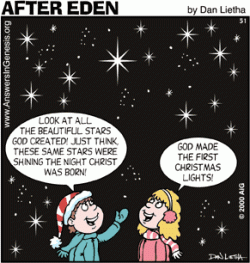
Did Adam See Stars?
God created the stars on Creation Day Four along with the sun and moon. This was two days before He created Adam on Creation Day Six.
Then God said, “Let there be lights in the expanse of the heavens to separate the day from the night, and let them be for signs and for seasons and for days and years; and let them be for lights in the expanse of the heavens to give light on the earth”; and it was so. God made the two great lights, the greater light to govern the day, and the lesser light to govern the night; He made the stars also. God placed them in the expanse of the heavens to give light on the earth, and to govern the day and the night, and to separate the light from the darkness; and God saw that it was good.
(Genesis 1:14-18 NASB)
The purpose for these “lights in the heavens” was “to divide the day from the night and for signs, and for seasons, and for days, and years and to give light on the earth.” (Genesis 1:14-15)
The stars would have to be visible to Adam for them to be of use in accomplishing these purposes. The Genesis 1:15 statement “and it was so” indicates the stars were functioning immediately for their intended purpose right from the beginning. So yes, Adam saw stars the first night he was alive.
As the earth orbits the sun, the progression of the seasons and the year are measured by the movement of the sun against the background stars. Without the background stars, we couldn’t determine the years and seasons. So the stars had to be visible from the beginning for Adam to use them to measure the passage of time.
For example, here is how the Big Dipper and Polaris contribute to fulfilling these purposes through measuring time and seasons.
The Big Dipper marks the seasons as it gradually shifts counterclockwise around Polaris throughout the year. The opening of its bowl always faces Polaris. At midnight on September 1 it is “beneath” Polaris “holding water”. As the seasons progress it orbits counterclockwise around Polaris with the handle trailing the bowl. At midnight on December 1 it is standing on its handle to the right of Polaris. At midnight on March 1 it is upside down above Polaris. And on midnight on June 1 it is standing on the bowl left of Polaris.
The Big Dipper is God’s Clock in the Sky. You can tell time at night from the position of the Big Dipper as it rotates around Polaris relative to the earth. The Big Dipper makes a complete circuit around Polaris every 24 hours. In 6 hours it moves 90 degrees, or 15 degrees every hour. From this information and that of the preceding paragraph, one can read the time at night from the position of the Big Dipper relative to Polaris.
The nearest star, Proxima Centauri, is 4 LY away and too faint to see with the naked eye. As a result, some people doubt Adam could have seen stars right away. They think it would have been at least 4 years before Adam saw any stars.

Light from distant stars is a difficult problem, but it’s important to realize that we don’t know what conditions were like at Creation. It’s possible the speed of light was infinite so that stars were instantly visible. Another clue mentioned 10 times in the Old Testament is that God “stretched out the heavens.” This could have a bearing on the transmission of light during Creation Week.
It is He who made the earth by His power, Who established the world by His wisdom, and by His understanding He stretched out the heavens. (Jeremiah 51:15 NASB)
(See also Psalm 104:2; Job 26:7; Isaiah 40:22; 42:5; 44:24; 45:12; 51:13; Jeremiah 10:12; Zechariah 12:1.)
Did Adam See the Big Dipper?
I don’t know which constellations Adam saw from the Garden of Eden, because it depends on Eden’s location. (See Where Was Adam’s Garden of Eden?) For example, to see the entire Big Dipper from the Southern Hemisphere, you must be north of 25 degrees south latitude.
But Adam lived for 930 years. He undoubtedly traveled around exploring the world God had made for him and his progeny. So I think it is certain that Adam saw the Big Dipper at some point during his life.
Adam’s lifespan of 930 years means the starlight problem does not arise for the Big Dipper. The distances of the Big Dipper stars from earth range from 83 LY (light-year) for Mizar to 124 LY for Dubhe.
It is quite likely that Adam began the study of astronomy. The stars were created for signs and for seasons and for days and years, so Adam would have needed to learn about them to be able to measure time.
Throughout Scripture Yahweh points to the heavens as reflectors of His glory.
The heavens declare the glory of God, and the sky above proclaims His handiwork. (Psalm 19:1 ESV)
This is something He would have shared with Adam in Eden and that Adam would have continued to study and marvel over.
The first-century Jewish historian Josephus reports that Adam’s son Seth and his descendants developed extensive astronomical knowledge and recorded it for posterity. Josephus says that Seth’s descendant Abraham taught this knowledge to the Egyptians.
(Flavius Josephus, Antiquities of the Jews, Book 1, Chap 2 Para 3 & Chap 8 Para 2.)
Where did Seth first learn about the stars? Just as I first learned about constellations as a boy from my father on camping trips, so I think Seth learned of them from his father Adam. Adam was 130 years old when Seth was born (Genesis 5:3), so he had plenty of time to learn a great deal of star lore to teach Seth.
Questions to Ponder
- The International Astronomical Union recognizes 88 constellations. Research and locate one in the sky that is new to you.
- From the information given in this article, can you figure out how to use the Big Dipper and Polaris to tell time at night?
Update: Click Big Dipper — Clock in the Sky for the answer.
Share your thoughts on these questions in the comments below. It could encourage or help another reader.
Soli Deo Gloria.
This is the 33rd of a series of weekly blog articles on Adam.
Read the prequels:
1. Was Adam in the Garden of Eden?
2. Did Moses Believe in Adam?
3. Did Jesus Believe in Adam?
4. Did Paul Believe in Adam?
5. Does Belief in Adam Matter?
6. Adam and Puppies
7. Why Did Adam Sin?
8. What Should Adam Have Done?
9. What Did Adam Cause?
10. What Was Adam’s Forbidden Fruit?
11. How Long Was Adam in Eden?
12. Was Adam’s Garden of Eden Real?
13. Christmas & Adam (with videos)
14. Where Was Adam’s Garden of Eden?
15. Did Adam Wear Clothes in Eden?
16. Was Adam Backward or Brilliant? (with video)
17. Who Was Mrs. Adam?
18. Adam’s Dream Girl
19. Adam’s Prolific Princess
20. Adam’s Problematic Princess
21. How Many Children Did Adam Have?
22. Whom Did Adam’s Sons Marry?
23. Did Adam Ride a Unicorn?
24. How Long Did Adam Live?
25. Did Adam Swat Mosquitoes in Eden?
26. Did Adam’s Garden Have a Talking Snake?
27. Why Should Adam’s Sin Affect Me?
28. Did Roses Have Thorns in Adam’s Garden?
29. Adam the Image-Bearer & Harambe the Gorilla
30. Did Adam Ever Return to Eden?
31. What Was Adam’s Tree of Life?
32. Will Adam Be in Heaven?
Read the sequels:
34. Did Adam Know Earth Is Round?
35. Did Jesus Say When Adam Was Created?
36. Did Adam See Dinosaurs?
37. Did Adam Like Steak?
38. Could Adam Read & Write?
39. Did God Use Evolution to Make Adam?
40. Adam & the Olympics
41. Adam and the Gospel
42. Adam and the Genesis Road
Subscribe – Don’t miss future blog posts!
Click the sidebar’s “SUBSCRIBE” button to follow the
Bible-Science Guy Blog. You’ll automatically receive
new posts free by email. Click SUBSCRIBE NOW!
©William T. Pelletier, Ph.D.
“contending earnestly for the faith”
“destroying speculations against the knowledge of God”
“for the defense of the gospel”
(Jude 1:3; 2 Cor 10:5; Phil 1:16)
Wednesday July 6, 2016 A.D.
The Lord God commanded the man, saying, “From any tree of the garden you may eat freely; but from the tree of the knowledge of good and evil you shall not eat, for in the day that you eat from it you will surely die.”
Now the serpent was more crafty than any beast of the field which the Lord God had made. And he said to the woman, “Indeed, has God said, ‘You shall not eat from any tree of the garden’?” The woman said to the serpent, “From the fruit of the trees of the garden we may eat; but from the fruit of the tree which is in the middle of the garden, God has said, ‘You shall not eat from it or touch it, or you will die.’” The serpent said to the woman, “You surely will not die! For God knows that in the day you eat from it your eyes will be opened, and you will be like God, knowing good and evil.” When the woman saw that the tree was good for food, and that it was a delight to the eyes, and that the tree was desirable to make one wise, she took from its fruit and ate; and she gave also to her husband with her, and he ate. (Genesis 2:16; 3:1-6 NASB)





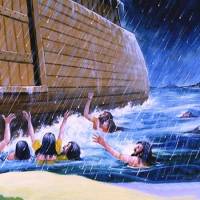
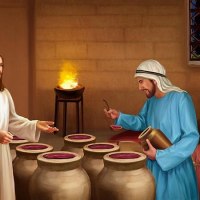

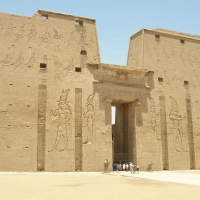
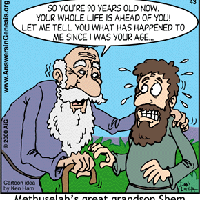

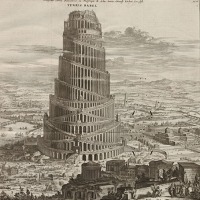


















Great post! I really like the part about the Big Dipper being the clock in the sky.
LikeLike
By: Historicus on July 6, 2016
at 3:20 pm
Love the article! Could you please explain more fully (or direct me to a source) concerning how the Big Dipper helps you determine the time at night? My difficulty is in distinguishing between the shifting counterclockwise around Polaris as it marks the seasons and rotating around Polaris as it tells time. I think I need a diagram to see the difference. Thanks for any help you can give!
Shannon Whealton Child of God, wife, mother, conservative.
LikeLike
By: lsrwhealton on July 6, 2016
at 9:00 pm
Watch for my blog post Big Dipper — Clock in the Sky in which I explain this … coming in the next few weeks.
LikeLike
By: BibleScienceGuy on September 10, 2016
at 8:03 pm